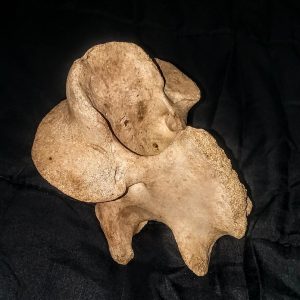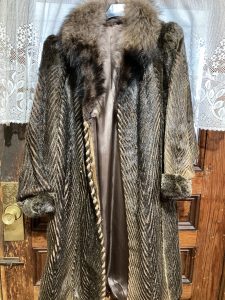Week 7 – Submissions – Theme “Death”
Abigail Epplett
Uxbridge, MA
M.A. Museum Studies, Office Manager at Fairlawn Christian Reformed Church
This bone is from a domesticated cow (Bos taurus) that lived and died on a beef cattle farm in Dudley, Massachusetts, which is about a thirty-minute drive from my house. It is an axis or C2 vertebra, which means it was the second vertebra in the cow’s neck. It connected to the atlas vertebra at the base of the cow’s skull and allowed the cow to turn its head. The main hole in the center of the bone protected the cow’s spinal cord, while smaller holes around the bone allowed nerves to connect to the main cord. The bone sustained some postmortem damage, perhaps nibbled by mice and deer as a calcium supplement before I found it in the woods.
The bone reminded me of Georgia O’Keeffe‘s paintings, which often feature cattle bones and other western motifs. Her art balances death and life, as longhorn skulls and arid landscapes are juxtaposed vibrant desert flowers.
The same balance of death and life can be seen in local farming, in which the cow played a small part. While agriculture in Massachusetts and the rest of New England had been in decline for several decades since the Industrial Revolution, it is fortunately no longer dying. According to the Massachusetts Agriculture Census, conducted by UMass Amherst’s Center for Agriculture, Food, and the Environmentin 2017, there are more than 7000 farms in my little state– up from around 4500 in 1974, the first year the census was held. While small farms were expected to disappear after the advent of genetically modified crops and enormous factory farms, they have instead evolved to find a niche in the slow food and organic movements.
The average person no longer farms and may not have a deep connection to their food, but there are still plenty of opportunities for agritourism in the region where the cow lived. Some of my local favorites are Wojcik Farm in Blackstone, Douglas Orchard & Farm in Douglas, West End Creamery & Farm in Whitinsville, and Foppema’s Farm in Northbridge. These are great places to see how local agriculture contributes to our food system, and how the cycle of life and death affects every season, from planting to growing to harvest.
Sayyara Huseynli
Medford, MA
M.A. Museum Education
I was getting frustrated in my search for an object which would fit the theme of “Death” when I noticed a door under the stairs. I have lived in this house for longer than a year but never paid attention to that door. As the door was located near to outside door and on the first floor, I imagined that it would be full of old or rarely used items, possibly old fashioned and dusty outwear. When I opened that door, I did indeed see some old coats. One of the them was an old vintage fur coat. I asked my landlord about that coat. She told me that inherited it after her mother passed away. Her sisters suggested for her to take the coat with her when she moved to Boston from Germany, as in their opinion Boston had colder winters then their home town.
The coat was made of real fur, but my landlord didn’t know which animal’s fur was used to make it. Because of the cruelty involved in the production of fur clothing, the coat symbolized Death to me.

